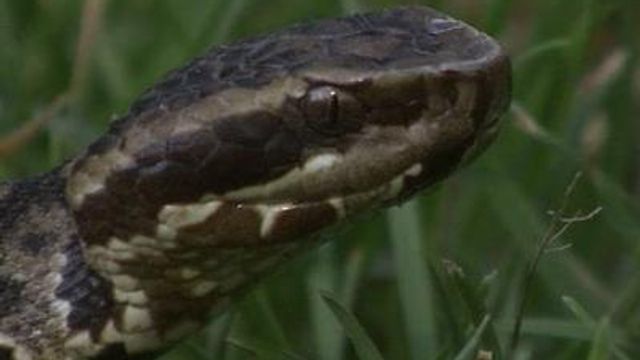Know what to do if a snake bites
Outdoors in the summertime? If so, you might be at a greater risk of crossing paths with a snake.
Posted — UpdatedIf so, you might be at a greater risk of crossing paths with a snake.
Dr. Brian Quigley, an emergency room physician at Rex Hospital in Raleigh, says that copperheads are the most common venomous snake in the Triangle and that people typically encounter them at construction sites, on farms or in garden areas.
They come in different shades and color intensity, but their copper-colored bands are shaped like an hourglass.
"Generally, their bites are not fatal," Quigley said. "They can be painful, and sometimes we give anti-venom."
To prevent bites, he recommends wearing boots that cover the ankles while walking in wooded areas.
Never try to pick a snake up or try to move it, regardless of what species it might be, he adds.
"The main thing is to just be aware of your environment," Quigley said. "Be aware that snakes may be out and may be active."
If you're bitten by a venomous snake, here's some other advice and things to know from medical experts:
- If the snake is venomous or you're unsure whether it is, go to the nearest emergency room and seek treatment immediately.
- Remain calm. Often, a snake doesn't release its venom when it strikes. It's just a warning to stay away. Baby copperheads, however, are more likely to release venom.
- Don't try to kill the snake or take it with you to the hospital. Instead, take notice of what it looks like so you can describe it to the medical professional treating you.
- Hospitals have anti-venom for pit vipers. Medical professionals will decide whether it is necessary, depending on your symptoms.
Although there are nearly 40 species of snakes in North Carolina, only six species – three rattlesnake species, copperhead, cottonmouth and coral – are venomous.
Rattlesnakes are more prevalent in the mountains and coastal plains.
Cottonmouths typically stay in water or swamp areas in the eastern half of the state.
Coral snakes are rare and typically spend their time underground. They are primarily located in the lower coastal plain and Sandhills.
• Credits
Copyright 2024 by Capitol Broadcasting Company. All rights reserved. This material may not be published, broadcast, rewritten or redistributed.





